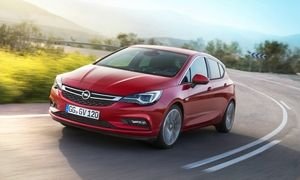VW Golf Challenged by New Opel Astra, Renault Megane in Europe's Compact Segment

Renault is also expected to rise several places in the segment because of the arrival of the new Megane, IHS Automotive forecasts.
Despite the fresh product the segment, which Europe’s second-largest overall after subcompacts, will continue to decline as buyers shift into similar-sized SUVs and crossovers such as the Nissan Qashqai and premium alternatives such as the BMW 1 series.
Sales in the compact sector have declined by more than 1 million cars from a volume of almost 4 million units in 2005, IHS figures show. Segment sales are forecast to dip to about 2.8 million by 2018, IHS predicts, but executives say that will not make the segment less interesting to them. “It’s still incredibly important to us,” Michael van der Sande, head of global marketing at Renault, told Automotive News Europe.

Technology showcase
Both the Megane and Astra were launched at this year’s Frankfurt auto show, where Renault and Opel highlighted their new models’ technology upgrades. Renault showcased the Megane’s large, portrait-sized touchscreen for the infotainment system and the four-wheel steering available on the top-of-the-line GT-badged variant.
Opel touted that the Astra will offer the first European version of parent General Motors’ OnStar in-car communication system complete with a 4G (LTE) WiFi hotspot and a smartphone link that brings either Apple CarPlay or Android Auto onto the car’s touchscreen.
“There’s a huge amount of tech that’s descended on the segment and we are now right back up to speed,” Renault’s van der Sande said. IHS predicts that Renault will sell about 190,000 Meganes in Europe next year, up from an estimated 130,000 this year. The surge is expected to push the Megane ahead of the Seat Leon and Peugeot 308 into fifth place, just behind the Skoda Octavia.
Opel is forecast to sell a little more than 300,000 Astras in Europe next year, which IHS expects will lift the car into second place in the segment from fifth, leaving it behind the Golf. Demand for the Astra and Megane are expected to contribute to the Golf’s volume dropping below the half-million sales VW’s top-seller achieved last year (the only car in Europe to do so). The analyst predicts VW will sell less than 400,000 Golfs by 2017.
The Astra and Megane are not significantly better than the Golf, said IHS analyst Ian Fletcher, who believes the cars will rise in the compact rankings because of their newness.
“The models that are being replaced will just take over from those that are starting to feel their age, the VW Golf, Ford Focus, Skoda Octavia and Peugeot 308 for example,” he told Automotive News Europe.
Ford of Europe President Jim Farley said that the Astra and Megane could have a big effect on the sector. “They’re good products, a lot of competition for us,” he told Automotive News Europe. A face-lift for the Focus helped push sales up 1.9% in the first nine months of this year to just under 250,000, figures from JATO Dynamics show (see below).

Wagons in, 3-doors out
While the previous-generation Megane and Astra model lines included three-door sporty coupes, neither Renault nor Opel has revealed plans for such a version for their new compacts. “It is a declining segment,” Renault’s Van der Sande said, without confirming the brand’s decision. “The sweet spot of the segment is the five-door.”
Opel, however, has announced it will add a station wagon version of the Astra, and Renault is likely to follow. All the biggest-selling compacts offer a wagon alternative in Europe and IHS figures predict that compact wagons will account for more than 850,000 units this year, the highest level in a decade.
The reason three-door variants are declining is because of the cost of tooling, IHS believes. Keeping costs low is crucial in a highly competitive sector where margins are tight. “Automakers are starting to find ways of making the segment profitable to some degree -- or at least not making a loss,” IHS’ Fletcher said. Platform sharing is one important cost-saving solution and Renault’s decision to put the Megane on the same CMF C-D platform as the Espace minivan, Kadjar compact SUV and Talisman midsize model, as well as alliance partner Nissan’s Qashqai and X-Trail SUVs, has paid off in terms of bringing in new technology, Renault believes. “It means we now have D-segment (midsize) technology in a C-segment car,” Van der Sande said.
Streamlining
Opel, meanwhile, has streamlined its diesel engine lineup for the Astra, which now offers three power outputs from the same 1.6-liter diesel, dropping the previous-generation car’s 1.3- and 2.0-liter units. “Being able to concentrate on fewer engines benefits both the customer and us,” Thomas Johnen, GM vice president for powertrain engineering in Europe, told Automotive News Europe.
GM expects the compact segment to be the first to show a serious customer shift away from increasingly costly diesels cars toward gasoline- or hybrid-powered models. “The C-segment is the one to watch,” Dan Nicholson, head of powertrain, told Automotive News Europe.
Analyst LMC Automotive predicts that the compact segment will shift from 48% diesel now based on 2015 European production figures to 38% by 2022. Said LMC powertrain analyst Al Bedwell: “This segment is more exposed than most.”
Nouvelles connexes


